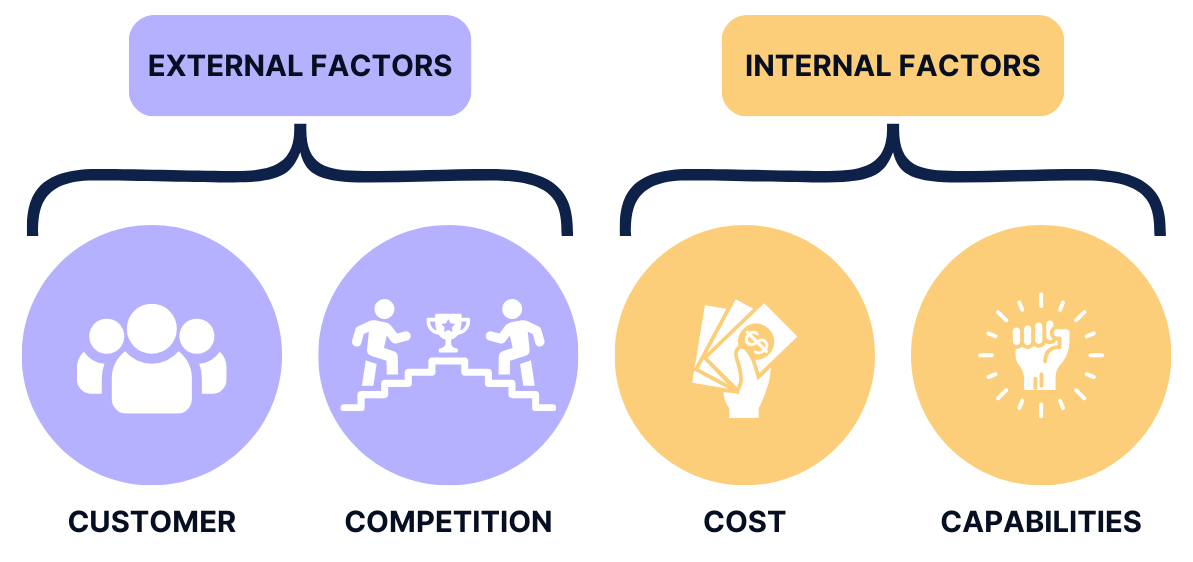What Is the 4C Framework?
The 4C framework serves as a structured model for strategic analysis and decision-making. It is composed of four elements: Customer, Competition, Cost, and Capabilities. While the former two provide information on external market conditions, the other two provide information on internal aspects of the company.

By systematically examining these elements, businesses gain insights into their target market, internal capabilities, competitive landscape, and potential partnerships. This holistic approach enables them to develop successful strategies that address customer needs, build on internal strengths, and realize growth opportunities.
Therefore, the 4C framework belongs to the basic tools, which serve as a general roadmap and reminder of the major aspects to cover when analyzing a firm’s positioning. The 3C Framework – Customer, Competition and Company is very similar except that the internal aspects of cost and capabilities are combined within the company.
Let’s take a closer look at what each C of the 4C framework stands for and what you should consider when analyzing the different categories:
Customer
By comprehending what customers value, businesses can customize their products, services, and marketing strategies to effectively meet their demands. This requires a clear understanding of the customer first. It is also important to realize that the customer of the firm is not necessarily the final consumer who buys the product.
There are many ways you can conduct a customer analysis, but all of them should have one thing in common: A structured approach. Before diving into the specifics of a company's customer base, it is important to have clearly defined the customers you are talking about.
One very common way to do this is segmentation. Define customer segments (and remember the MECE Principle), prioritize them based on their relevance (Pareto Principle) and focus on the most important customer segment first.
Examples for possible customer segmentations are:
- Demographic Segmentation: Dividing customers based on demographic factors such as age, gender, income, education, marital status, and occupation.
- Geographic Segmentation: Segmenting customers based on their geographic location, such as country, region, city, or climate.
- Psychographic Segmentation: Grouping customers based on their lifestyles, values, attitudes, interests, and personalities.
- Behavioral Segmentation: Segmenting customers based on their purchasing behavior, usage patterns, brand loyalty, and product preferences.
- Usage Segmentation: Dividing customers based on how frequently they use a product or service.
💡 Pro Tipp: Visualize your customer segmentation with the help of an issue tree and demonstrate to your interviewer that you not only think like a consultant, but take notes like one as well.
Once you have got a clear picture of the customer segment in focus, you can dive deeper into the characteristics, preferences, motivations, and behaviors of the customers within the segment. Gain an understanding of their needs and preferences and analyze available data to identify trends and further insights.
Relevant aspects could be:
- Main problems, special needs and wishes: What are the main problems, challenges, or aspirations of our target customers?
- Loyalty: How loyal are our customers? What factors contribute to their loyalty, and how can we further strengthen it?
- Customer satisfaction: How satisfied are our customers with our products or services? What aspects do they appreciate the most? Where do they see room for improvement? What are the key benefits or value propositions that resonate with our target customers?
- Distribution channels: What are the most effective channels to reach and engage with our target customers?
The goal is to identify opportunities and challenges within the customer segment and based on that give valuable recommendations for the company’s strategy.
Competition
Analyzing the competition entails evaluating the strengths, weaknesses, strategies, and market positioning of the competitors in the market. This analysis enables you to pinpoint major competitors in terms of their market share, pricing strategy, distribution networks and additional elements that influence their competitive edge.
To find out more about the competition, further information on the following aspects may be relevant:
- Competitor overview: Who are our main competitors in the market? What are their strengths and weaknesses? How do our competitors differentiate themselves from each other and from us?
- Competitive position, portrayed through the share and relative share of the market: What is our competitors' market share, and how does it compare to ours?
- Growth of the last years and expected growth: What information do we have on the growth of the competition in recent years? What growth is the competition expecting this year and in the next 5 years?
- Performance: How does the competitor's profitability compare with ours?
- Marketing strategies: What strategies are our competitors using to attract and retain customers? How do our competitors distribute their products or services? Are there any gaps or opportunities in their distribution channels?
- Pricing strategies: How do our competitors' pricing strategies compare to ours? Are they undercutting us, or do they offer premium pricing?
- Other trends: Are there any other trends that the competition is taking advantage of that we haven't thought about yet?
As for all analysis (and cases in consulting interviews) structure is key to success when getting an overview of the competitive landscape. It may be helpful to differentiate different categories of competitors (think of segmentation again), and compare them based on the same criteria (take a look at the 4P framework for inspiration, but remember that the ways are manifold, and it is always better to develop your own structure than use standardized frameworks). A good way to visualize the outcome of your competitor analysis is by mapping the competitive environment in a 2x2 Matrix.
If you have done solid work in your competitor analysis, strengths and weaknesses of your company will become quite clear, making it easy to come up with recommendations to enhance your business’s growth.
👉 For further insights, we recommend our article about Competitive Response Cases.
Costs
When looking at the costs segment, your primary goal is to compare your client’s cost structure with the competition’s cost structure. Next, you try to reduce your client’s costs if certain components of the competitor's costs are lower. We have listed the facts you can consider in terms of costs and the questions you can ask to obtain this information here:
- Cost structure: What are the primary cost drivers for our business? Are there any significant cost components that we need to address? How are fixed and variable costs divided?
- Profitability by customers, product lines, geography: What is the profitability of each product or service offering? Are there any products or services that are not contributing to our bottom line?
- Influence of external factors: How do fluctuations in external factors (e.g., economic conditions, regulatory changes) affect our cost structure and pricing decisions?
Again, the aim is to collect relevant information in a structured manner and use that information to develop strategic recommendations. To reduce costs you will most likely look out for opportunities to streamline operations, improve efficiency, or optimize processes.
Capabilities
The capabilities of a firm are basically the resources it can rely on. If you have a good understanding of the company’s capabilities, you are able to judge more precisely what kind of strategies the company can apply to boost its per formance. Furthermore, you can decide if the company should rather make something by itself (organic) or buy the competencies from outside (inorganic - e.g., buying a new firm). Below are some examples of the company's capabilities, including possible questions you can ask to get this information:
- Core competencies: What are our core competencies as an organization? What do we do exceptionally well?
- Human resources: What is the skill level and expertise of our workforce? Do we have the right talent in place to execute our strategies effectively?
- Technological capabilities: How do our technological capabilities compare to those of our competitors? Are there any areas where we're falling behind?
- Value for the customers: What unique resources or assets do we possess that give us a competitive advantage?
- Financial resources: What about the company's financial resources? Are there any unused financial opportunities?
- Organizational culture: What is our organizational culture like? Does it support innovation, collaboration, and agility?
Why Is the 4C Framework Used in Case Interviews?
In case interviews for management consulting roles, the 4C framework is often used for market entry or growth strategy cases. It can serve as a baseline to structure your analysis, but make sure to adjust it individually to the case you were given.
The simplest way to adapt the 4C framework is to prioritize the Cs based on their relevance to the specific problem you’re solving. In some cases, you may start with one category, only to find that the case naturally evolves in a way that requires you to focus entirely on that area, without addressing the others. That’s why it’s crucial not to memorize frameworks and apply them rigidly. Instead, you should truly understand the logic behind structured problem-solving and be able to apply it flexibly. Developing this skill takes practice—run mock interviews with peers (check out our meeting-board) or work with a coach to get valuable feedback and refine your approach.
However, the 4C framework is often used by candidates in case interviews, as it offers a very structured and easy-to-understand introduction to the analysis. Here are the advantages of this framework:
✓ Customer-centric: The 4C framework prioritizes understanding and addressing customer needs, enhancing product, service, and marketing alignment, which boosts customer satisfaction and loyalty.
✓ Comprehensive: The framework examines various factors such as customers, competition, costs, and capabilities, providing a deep insight into both external and internal business environments and aiding in strategic alignment with business goals.
✓ Systematic: The 4C framework facilitates informed decision-making by methodically evaluating essential business aspects, helping identify strengths, improvement areas, and growth opportunities.
✓ Adaptable: Suitable for diverse industries, the framework allows businesses to tailor their analysis to meet specific challenges and capitalize on unique market opportunities.
Key Takeaways – What You Should Know About the 4C Framework
Overall, the 4C Framework is a helpful tool for carrying out a strategic analysis of a business and deriving corresponding proposals for action. When using the framework, however, you should bear in mind that it divides complex business situations into just 4 areas: Customer, Competition, Cost, and Capabilities. Customer and Competition provide an external view, while Cost and Capabilities give an internal perspective. Other factors that should play a role in an in-depth analysis as well are neglected in the framework. Furthermore, the 4C framework does not provide any guidelines for implementing specific strategies in the company.

